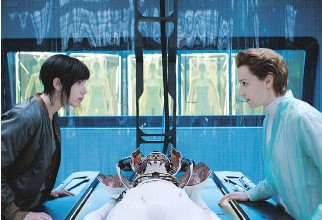 PARAMOUNT PICTURES
PARAMOUNT PICTURESScarlett Johansson was memorable if invisible as the voice of an operating system that falls in love with Joaquin Phoenix in Her. She was all physicality in Jonathan Glazer’s alien thriller Under the Skin. And so, accusations of whitewashing aside, she seems perfect to embody Major, the cyborg-human hybrid at the centre of the existential sci-fi action flick Ghost in the Shell.
Major combines a human brain in a robot body. In an opening sequence that borrows liberally from Westworld, Blade Runner, The Matrix and more, we learn that her original body was killed in a refugee crisis. Her new one belongs to the Hanka Corporation, which means that, legally, so does she. “My name is Major Mira Killian and I give my consent,” she rattles off whenever the company wants to modify her, but the line is delivered with all the introspection of someone clicking “accept” at the bottom of a 27-page iTunes agreement.
Hanka is run by Cutter (Peter Ferdinando) but personified by the more kindly Dr. Ouelet (Juliette Binoche), who has a maternal relationship with Major. But she mostly takes her orders from Aramaki (Takeshi Kitano), a Zen security chief. In a nice touch, he speaks only Japanese, while his underlings respond in English. Major’s closest comrade is Batou, embodied by the wonderfully sympathetic Danish actor Pilou Asbaek.
As imagined by director Rupert Sanders (Snow White and the Huntsman), the future is a busy, scary place. Giant advertising holograms tower over the unnamed port city where the action happens: The effect is like Blade Runner on steroids, and the film skirts dangerously close to creating sensory overload in its viewers. Digital fish prowl the streets, as though a ’90s screensaver had broken out of its monitor.
Major’s brain-in-a-robot existence is only the most extreme example of future tech gone wild. Humans go in for “upgrades,” whether necessary — Batou’s new eyes — or purely gratuitous, like the character who boasts that his new synthliver means “It’s last call every night.” There’s an app for telepathy and robot geishas. But oddly, no self-driving cars.
But the story, beneath all the science-fiction and action-movie trappings, is fairly simple. Someone is threatening Hanka, and Major and the rest of her team have to figure out who is doing it and why. The first question turns out to be easy: It’s Kuze (Michael
Pitt), who in a delicious throwback stutters like Max Headroom. (The original Japanese manga is from the ’80s, after all.) His reasons turn out to be more complex than I should probably let on.
But the filmmakers have opted for flash over contemplation, image over reflection. Major is troubled by lifelike visions that come unbidden into her consciousness — or as you and I would call them, memories. And more than one character remarks that we are defined not by our memories but by our actions. That’s a great philosophical leaping-off point, but the screenplay, by Jamie Moss and William Wheeler, leaves it hanging and undeveloped.
The film’s slick packaging almost makes up for its lack of thoughtfulness — certainly it provides a distraction on par with Johansson’s flesh-toned combat suit, which renders her semi-invisible, emphasis on the semi. But this Ghost in the Shell, like the various books, films, video games and TV series before it, owes a debt to the mind-body problem, as raised by René Desartes and critiqued by Gilbert Ryle, whose phrase “the ghost in the machine” inspired the title.
There is some food for thought in this iteration, but by the time Hanka’s CEO rolls out the spider-tank (pretty much what you’d imagine), it’s clear that this ambitious effort has become a shell game with too much shell and not nearly enough ghost.
